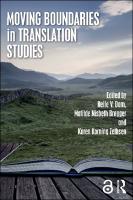Moving Boundaries in Translation Studies
Proposal review
| dc.contributor.editor | Dam, Helle V. | |
| dc.contributor.editor | Brøgger, Matilde Nisbeth | |
| dc.contributor.editor | Zethsen, Karen Korning | |
| dc.date.accessioned | 2022-01-25T10:35:23Z | |
| dc.date.available | 2022-01-25T10:35:23Z | |
| dc.date.issued | 2019 | |
| dc.identifier | ONIX_20220125_9781351348720_4 | |
| dc.identifier | OCN: 1053623346 | |
| dc.identifier.uri | https://library.oapen.org/handle/20.500.12657/52573 | |
| dc.description.abstract | Translation is in motion. Both translation practice and translation studies (TS) have seen considerable innovation in recent decades, and we are currently witnessing a wealth of new approaches and concepts, some of which refect new translation phenomena, whereas others mirror new scholarly foci. Volunteer translation, crowdsourcing, virtual translator networks, transediting, and translanguaging are only some examples of practices and notions that are emerging on the scene alongside a renewed focus on well-established concepts that have traditionally been considered peripheral to the practice and study of translation: intralingual and intersemiotic translation are cases in point. At the same time, technological innovation and global developments such as the spread of English as a lingua franca are affecting wide areas of translation and, with it, translation studies. These trends are currently pushing or even crossing our traditional understandings of translation (studies) and its boundaries. The question is: how to deal with these developments? Some areas of the translation profession seem to respond by widening its borders, adding new practices such as technical writing, localisation, transcreation, or post-editing to their job portfolios, whereas others seem to be closing ranks. The same trend can be observed in the academic discipline: some branches of translation studies are eager to embrace all new developments under the TS umbrella, whereas others tend to dismiss (some of) them as irrelevant or as merely refecting new names for age-old practices. Translation is in motion. Technological developments, digitalisation and globalisation are among the many factors affecting and changing translation and, with it, translation studies. Moving Boundaries in Translation Studies offers a bird’s-eye view of recent developments and discusses their implications for the boundaries of the discipline. With 15 chapters written by leading translation scholars from around the world, the book analyses new translation phenomena, new practices and tools, new forms of organisation, new concepts and names as well as new scholarly approaches and methods. This is key reading for scholars, researchers and advanced students of translation and interpreting studies. The Open Access version of this book, available at http://www.taylorfrancis.com, has been made available under a Creative Commons Attribution-Non Commercial-No Derivatives 4.0 license | |
| dc.language | English | |
| dc.subject.classification | thema EDItEUR::C Language and Linguistics::CF Linguistics | en_US |
| dc.subject.other | Andrew Chesterman | |
| dc.subject.other | Arnt Lykke Jakobsen | |
| dc.subject.other | Conceptual boundaries | |
| dc.subject.other | Ergonomics of translation | |
| dc.subject.other | Franz Pöchhacker | |
| dc.subject.other | Helle V. Dam | |
| dc.subject.other | Julie McDonough Dolmaya | |
| dc.subject.other | Karen Korning Zethsen | |
| dc.subject.other | Literary Translation | |
| dc.subject.other | Localisation research in translation studies | |
| dc.subject.other | Luc van Doorslaer | |
| dc.subject.other | Margaret Rogers | |
| dc.subject.other | Matilde Nisbeth Brogger | |
| dc.subject.other | Matilde Nisbeth Brøgger | |
| dc.subject.other | Maureen Ehrensberger-Dow | |
| dc.subject.other | Miguel A. Jiménez-Crespo | |
| dc.subject.other | Moving Boundaries in Translation Studies | |
| dc.subject.other | Moving boundaries in interpreting | |
| dc.subject.other | Nadja Grbić | |
| dc.subject.other | Non-literary translation | |
| dc.subject.other | Owen Conlan | |
| dc.subject.other | Özlem Berk Albachten | |
| dc.subject.other | Pekka Kujamäki | |
| dc.subject.other | Personalising translation technology | |
| dc.subject.other | Post-editing | |
| dc.subject.other | Professional translation | |
| dc.subject.other | Riitta Jääskeläinen | |
| dc.subject.other | Sara Laviosa | |
| dc.subject.other | Sharon O'Brien | |
| dc.subject.other | Translanguaging | |
| dc.title | Moving Boundaries in Translation Studies | |
| dc.type | book | |
| oapen.identifier.doi | 10.4324/9781315121871 | |
| oapen.relation.isPublishedBy | 7b3c7b10-5b1e-40b3-860e-c6dd5197f0bb | |
| oapen.relation.isbn | 9781351348720 | |
| oapen.relation.isbn | 9781138563667 | |
| oapen.relation.isbn | 9781138563650 | |
| oapen.relation.isbn | 9781315121871 | |
| oapen.imprint | Routledge | |
| oapen.pages | 248 | |
| peerreview.anonymity | Single-anonymised | |
| peerreview.id | bc80075c-96cc-4740-a9f3-a234bc2598f1 | |
| peerreview.open.review | No | |
| peerreview.publish.responsibility | Publisher | |
| peerreview.review.stage | Pre-publication | |
| peerreview.review.type | Proposal | |
| peerreview.reviewer.type | Internal editor | |
| peerreview.reviewer.type | External peer reviewer | |
| peerreview.title | Proposal review | |
| oapen.review.comments | Taylor & Francis open access titles are reviewed as a minimum at proposal stage by at least two external peer reviewers and an internal editor (additional reviews may be sought and additional content reviewed as required). |

